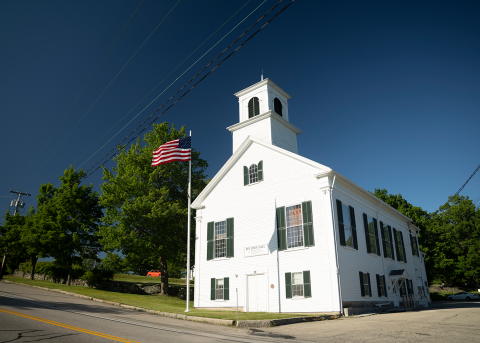Drive across New Hampshire and you will see physical clues to the past – stone walls mark property boundaries in fields and woods; post and beam framing holds up barns; stained glass windows shine light into churches.
It’s a history that requires specific skills to be maintained. While it was once common for young adults to learn trades, the Northeast is now experiencing a severe workforce shortage in masonry, carpentry, materials conservation, plastering, decorative finishes, windows and iron work, among other trades specializations.
To better understand the challenges facing these industries, UNH Extension field specialist Jada Lindblom led a research project with Extension staff and colleagues from four partner organizations – New Hampshire Preservation Alliance, Preservation League of New York State, Preservation Trust of Vermont and Maine Preservation, together comprising the Northeast Regional Initiative for the Preservation Trades.

This project was supported in part by grants from the Moe Family Fund for Statewide and Local Partners through the National Trust for Historic Preservation and the 1772 Foundation.
The team employed a multiple-methods research approach including a survey, interviews and focus groups to understand the experiences and perceptions of current preservation trades professionals. They also gathered information about training and recruitment gaps and opportunities and recommended courses of action to create a more robust and sustainable workforce.
Historic preservation remains a critical element of community vitality. Preservation fosters a strong sense of place and connection to local heritage, while also providing jobs. A labor study from the Campaign for Historic Trades estimated the rehabilitation of buildings represents an estimated $85 billion and creates 165,000 jobs annually across the United States.
Preservation practices also offer important environmental sustainability strategies for climate change mitigation and resource conservation. Many older homes in the Northeast need rehabilitation to be livable and safe, and these efforts can be especially useful considering current affordable housing shortages.
The “Understanding and Advancing the Preservation Trades” report indicates that more training opportunities and awareness of preservation careers is needed – 93% of survey respondents agreed that young people lack knowledge about career possibilities in preservation trades and 86% agreed that young people are often discouraged from exploring careers in trades.
A common theme across this research is frustration and regret that so many middle and high schools in the Northeast have eliminated the requirement or availability of shop class and related hands-on instructional offerings. Research participants identified high schools and middle schools as key components to improving the preservation trades workforce.
In addition to the formal training in schools, there is a need for knowledge transfer from current workers, but because these professions often require long hours of exhausting, physical, independent work, there can be strains on time and finances.
One survey respondent wrote, “Training is inadequate because it does not involve formalized on-the-job training. Internships are essential for this trade to continue. Apprenticeships that formalize training with accountability are non-existent.”

This research also shows that while preservation trades in the Northeast have historically been dominated by white men, the workforce is diversifying and there are opportunities to build upon this momentum of change. Women are increasingly entering the trades, but gender biases and discrimination can still occur.
To diversify the preservation trades workforce, efforts can be made to reduce the stigma associated with careers in the trades. One interview participant shared, “The most important thing is to change the narrative surrounding trades and create a new narrative of one with good pay, great benefits and a great working environment to get young people interested in joining the movement.” As the demand for tradespeople has grown, many preservation trades specialists report that earning potentials have increased and general attitudes about their careers are shifting.
The report offers several action items such as identifying opportunities for advancement through policy making and advocacy; expanding continuing education offerings to better support existing practitioners and small businesses; and hosting social and educational events and forums.
Following the release of the report, the New Hampshire Preservation Alliance formed the Preservation Trades Workforce Development Initiative, which has received $90,000 in Community Development Finance Authority tax credits. The tax credits will support three campaigns directed at matching students to employers and historic buildings in need of work.
Lindblom says that the momentum from the regional initiative has been encouraging. Extension and the partner organizations continue to get calls and emails from tradespeople, educators and workforce development professionals who want to be a part of the solution.
“With continued attention and investment, we can show young people and career seekers how creative, interesting and rewarding the preservation trades can be,” she says.
UNH Extension Research Team
Project Lead: Jada Lindblom, field specialist
Scott Slattery, field specialist
Molly Donovan, former state specialist


